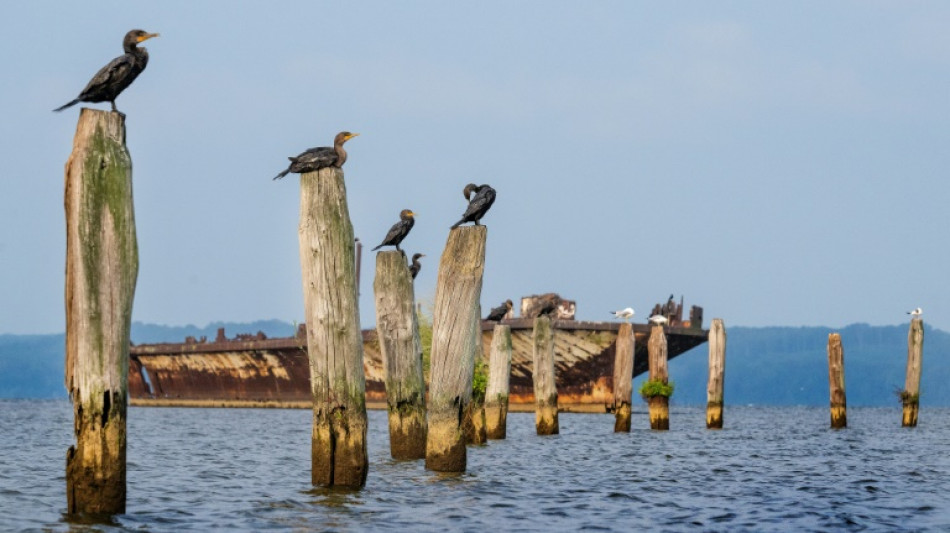
-
 Georgia ruling party wins local polls as mass protests flare
Georgia ruling party wins local polls as mass protests flare
-
Depoortere stakes France claim as Bordeaux-Begles stumble past Lyon

-
 Vinicius double helps Real Madrid beat Villarreal
Vinicius double helps Real Madrid beat Villarreal
-
New museum examines family life of Mexican artist Frida Kahlo

-
 Piccioli sets new Balenciaga beat, with support from Meghan Markle
Piccioli sets new Balenciaga beat, with support from Meghan Markle
-
Lammens must be ready for 'massive' Man Utd scrutiny, says Amorim

-
 Arteta 'not positive' after Odegaard sets unwanted injury record
Arteta 'not positive' after Odegaard sets unwanted injury record
-
Slot struggles to solve Liverpool problems after third successive loss

-
 Netanyahu hopes to bring Gaza hostages home within days as negotiators head to Cairo
Netanyahu hopes to bring Gaza hostages home within days as negotiators head to Cairo
-
Ex-NFL QB Sanchez in hospital after reported stabbing

-
 Liverpool lose again at Chelsea, Arsenal go top of Premier League
Liverpool lose again at Chelsea, Arsenal go top of Premier League
-
Liverpool suffer third successive loss as Estevao strikes late for Chelsea

-
 Diaz dazzles early and Kane strikes again as Bayern beat Frankfurt
Diaz dazzles early and Kane strikes again as Bayern beat Frankfurt
-
De Zerbi living his best life as Marseille go top of Ligue 1

-
 US envoys head to Mideast as Trump warns Hamas against peace deal delay
US envoys head to Mideast as Trump warns Hamas against peace deal delay
-
In-form Inter sweep past Cremonese to join Serie A leaders

-
 Kolisi hopes Rugby Championship success makes South Africa 'walk tall' again
Kolisi hopes Rugby Championship success makes South Africa 'walk tall' again
-
Ex-All Black Nonu rolls back the years again as Toulon cruise past Pau

-
 Hundreds of thousands turn out at pro-Palestinian marches in Europe
Hundreds of thousands turn out at pro-Palestinian marches in Europe
-
Vollering powers to European women's road race title

-
 Struggling McLaren hit bump in the road on Singapore streets
Struggling McLaren hit bump in the road on Singapore streets
-
'We were treated like animals', deported Gaza flotilla activists say

-
 Czech billionaire ex-PM's party tops parliamentary vote
Czech billionaire ex-PM's party tops parliamentary vote
-
Trump enovys head to Egypt as Hamas agrees to free hostages

-
 Arsenal go top of Premier League as Man Utd ease pressure on Amorim
Arsenal go top of Premier League as Man Utd ease pressure on Amorim
-
Thousands attend banned Pride march in Hungarian city Pecs

-
 Consent gives Morris and Prescott another memorable Arc weekend
Consent gives Morris and Prescott another memorable Arc weekend
-
Georgian police fire tear gas as protesters try to enter presidential palace

-
 Vollering powers to European road race title
Vollering powers to European road race title
-
Reinach and Marx star as Springboks beat Argentina to retain Rugby Championship

-
 Russell celebrates 'amazing' Singapore pole as McLarens struggle
Russell celebrates 'amazing' Singapore pole as McLarens struggle
-
Czech billionaire ex-PM's party leads in parliamentary vote

-
 South Africa edge Argentina to retain Rugby Championship
South Africa edge Argentina to retain Rugby Championship
-
'Everyone's older brother': Slipper bows out in Wallabies loss

-
 Thousands rally in Georgia election-day protest
Thousands rally in Georgia election-day protest
-
Sinner starts Shanghai defence in style as Zverev defies toe trouble

-
 Russell takes pole position for Singapore Grand Prix as McLaren struggle
Russell takes pole position for Singapore Grand Prix as McLaren struggle
-
Robertson praises All Blacks 'grit' in Australia win

-
 Government, protesters reach deal to end unrest in Pakistan's Kashmir
Government, protesters reach deal to end unrest in Pakistan's Kashmir
-
Kudus fires Spurs into second with win at Leeds

-
 Rival rallies in Madagascar after deadly Gen Z protests
Rival rallies in Madagascar after deadly Gen Z protests
-
Egypt opens one of Valley of the Kings' largest tombs to public

-
 Ethiopia hits back at 'false' Egyptian claims over mega-dam
Ethiopia hits back at 'false' Egyptian claims over mega-dam
-
Sinner breezes past Altmaier to launch Shanghai title defence

-
 Czech ex-PM set to win vote, putting Ukraine aid in doubt
Czech ex-PM set to win vote, putting Ukraine aid in doubt
-
All Blacks down Wallabies to stay in Rugby Championship title hunt

-
 Gazans hail Trump ceasefire call as Hamas agrees to free hostages
Gazans hail Trump ceasefire call as Hamas agrees to free hostages
-
Zverev echoes Federer over tournaments 'favouring Sinner, Alcaraz'

-
 Yamal injury complicated, return date uncertain: Barca coach Flick
Yamal injury complicated, return date uncertain: Barca coach Flick
-
Conservative Takaichi set to be Japan's first woman PM


New research reveals where N. American bird populations are crashing
Birds are facing a population crisis, but a lack of high-quality localized data has made it difficult to understand the drivers behind specific declines and to craft effective conservation responses.
Now, a team of researchers has developed an innovative solution, combining vast amounts of data from a popular birding app with machine learning and advanced statistical methods to overcome the challenges posed by large-scale citizen science projects.
Their study, published Thursday in Science, reveals that North American bird populations are being hit hardest in their traditional strongholds, as rapid environmental shifts -- including climate change -- disrupt these once-reliable refuges.
"We have known for a long time that bird populations are declining," lead author Alison Johnston, an ornithologist and ecological statistician at the University of St Andrews, told AFP.
"What we aimed to do here was to look at better population trends in much more detail," she said -- data that is "a lot more tailored for conservation decisions and understanding what we can actually do on the ground."
A landmark 2019 paper also in Science found that North America had lost 2.9 billion breeding adult birds between 1970 and 2017 -- a net loss of nearly a third. The 2025 US State of the Birds report found continued declines in nearly every ecological biome.
Birds play vital roles in ecosystems, from pollinating plants and dispersing seeds to controlling pests.
Their loss disrupts food chains, undermines forest health, reduces crop yields -- and deprives people of the joy of watching species that have long been part of human culture.
But the threats are diverse: from prairie loss impacting Baird's Sparrows in the Midwest to Hawaiian birds threatened by rising seas and invasive predators, including cats.
Johnston and colleagues turned to eBird, an open-source project, analyzing 36 million observations spanning 2007 to 2021 across North America, Central America, and the Caribbean.
A major challenge with citizen science data is separating changes in bird populations from changes in how people watch birds.
The team overcame this with several innovations: using only checklists where observers recorded all species seen; accounting for variables like observation time and distance traveled; and applying a machine learning model that controlled for shifting birding behavior.
They validated the approach through thousands of simulations, ultimately focusing on 495 species for which the results proved reliable.
Unlike previous monitoring that tracked trends at the state or regional level, their analysis looked at plots 27 kilometers by 27 kilometers (17 miles by 17 miles) -- roughly the size of New York City.
Key findings included that 97 percent of species had both areas of increasing population and areas of decline, revealing hidden complexity.
Wood ducks for instance are declining in the Southeast US but thriving farther north, suggesting a climate-related shift.
The study also found that 83 percent of species are shrinking fastest in areas where they were most abundant, particularly grassland and aridland breeders.
The reasons aren't fully known, but one theory is that birds adapted to rich environments may be less resilient to rapid change than those evolved for harsher conditions.
Conversely, some aridland, forest, and generalist species are rebounding in parts of their range where they were once scarce -- pointing to pockets of opportunity.
The findings are already being used by wildlife agencies, for example in permitting wind energy projects to minimize impacts on species such as Bald Eagles.
P.Vogel--VB




